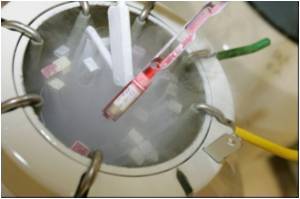TAp63a belongs to tumor suppressor family ensures the elimination of damaged cells before they reach maturity. This is the key quality control process in the immature cells (oocytes).

But it seems that plenty of TAp63a is always around, whether oocytes are damaged or not, suggesting that there must be a very special way that the protein is kept under wraps lest it kill off perfectly good cells. A team lead by Volker D'tsch of Goethe University has figured out how that works.
The quality control factor normally exists in oocytes in inactive pairs or dimers, he explained. When double strand breaks to the DNA occur, those dimers are chemically modified by an as-yet unidentified enzyme, allowing them to open up and join forces with a second open pair. The result is an active tetramer that can bind DNA more effectively, leading to the death of the damaged cells.
That activation of TAp63a cannot be undone, they show, even if you reverse the chemical modification that enabled the tetramer formation in the first place. That irreversibility stems from an extra helix structure that keeps the tetramer stable.
"It's all or nothing," D'tsch said. "Once activated, the path to cell death is decided."
D'tsch believes that this quality control of the genetic integrity of oocytes likely represents the original function of the p53 family, with cell cycle arrest and tumor suppression arising as later evolutionary developments. That's because p53-like genes are found in invertebrates, including tiny nematode worms.
Advertisement
The findings also help to explain what happens in young women who undergo chemotherapy that so often leads them to become infertile as a result, D'tsch noted. It may even be possible to devise strategies to counteract the players responsible for activating TAp63a once it is found or others in the pathway, he said. Unfortunately, that might not be such a good idea.
Advertisement
Source-Eurekalert








